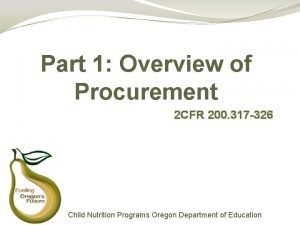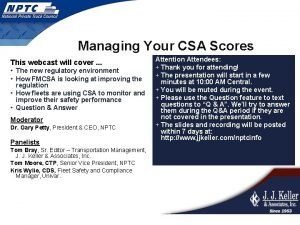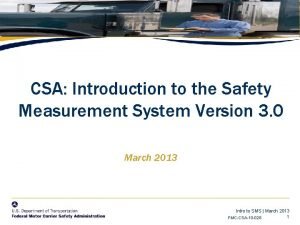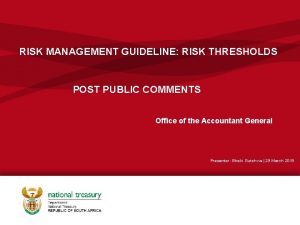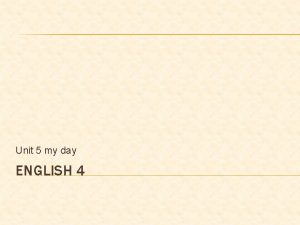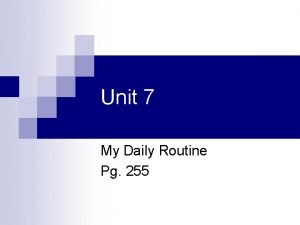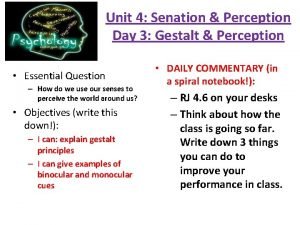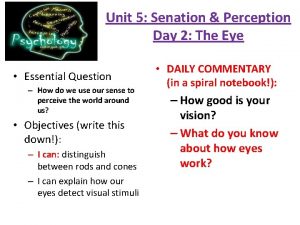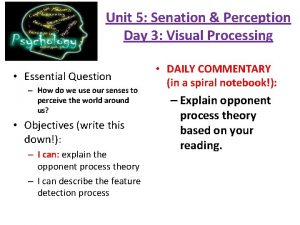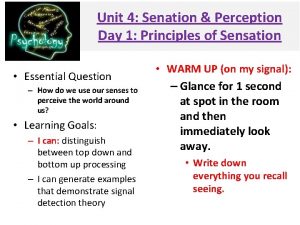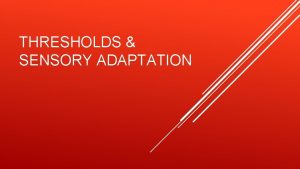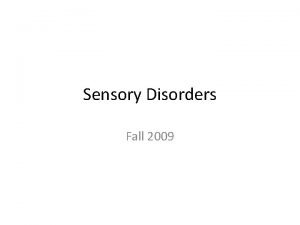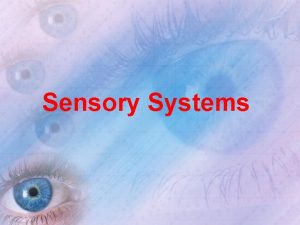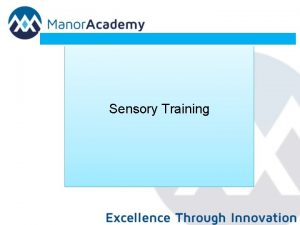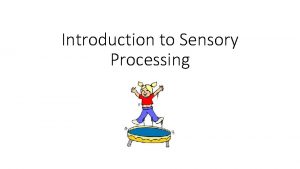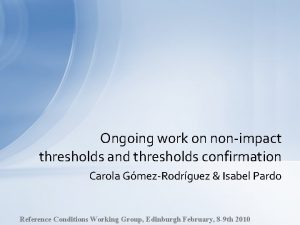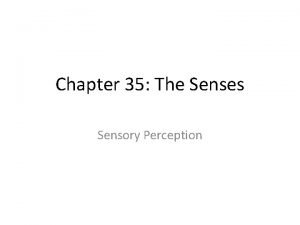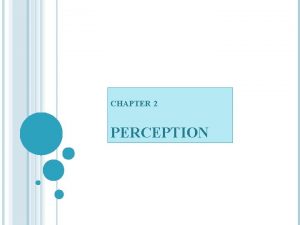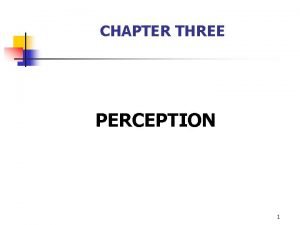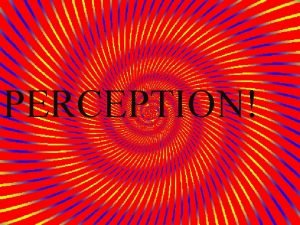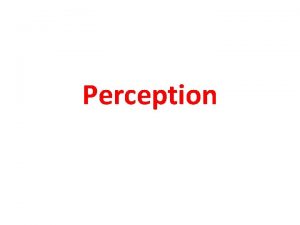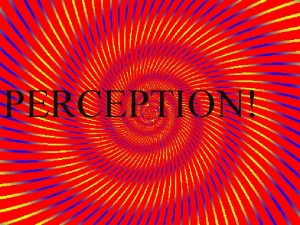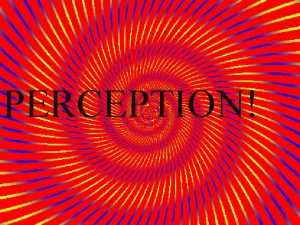Unit 5 Senation Perception Day 1 Sensory Thresholds























- Slides: 23

Unit 5: Senation & Perception Day 1: Sensory Thresholds & The Eye • Essential Question – How do we use our senses to perceive the world around us? • Objectives (write this down!): – I can: distinguish between top down and bottom up processing – I can generate examples that demonstrate signal detection theory • ON YOUR DESK: – RJ 5. 1 & 5. 2 • DAILY COMMENTARY (in a spiral notebook!): – Glance for 1 second at spot in the room and then immediately look away. • Write down everything you recall seeing.

Unit 5: Senation & Perception Day 1: Sensory Thresholds • Today: – – – DC Unit Overview Review Unit Project Notes Activity • For Tonight: – RJ 5. 3 • Myers 204 -208 • Griggs 87 -90 • DUE FRIDAY: – Tatum Take Home

Unit Project • Sensation Children’s Book


Sensation & Perception How do we construct our representations of the external world? To represent the world, we must detect physical energy (a stimulus) from the environment and convert it into neural signals. This is a process called sensation. When we select, organize, and interpret our sensations, the process is called perception. 5

Top-Down Processing: PERCEPTION Information processing guided by higher-level mental processes as we construct perceptions, drawing on our experience and expectations. THE CHT 6

Making Sense of Complexity Our sensory and perceptual processes work together to help us sort out complex images. “The Forest Has Eyes, ” Bev Doolittle 7

Sensing the World Senses are nature’s gift that suit an organism’s needs. A frog feeds on flying insects; a male silkworm moth is sensitive to female sex-attractant odor; and we as human beings are sensitive to sound frequencies that represent the range of human voice. 8

Exploring the Senses 1. What stimuli cross our threshold for conscious awareness? 2. Could we be influenced by stimuli too weak (subliminal) to be perceived? 3. Why are we unaware of unchanging stimuli, like a band-aid on our skin? 9

Psychophysics A study of the relationship between physical characteristics of stimuli and our psychological experience with them. Physical World Psychological World Light Brightness Sound Volume Pressure Weight Sugar Sweet 10

Detection Absolute Threshold Intensity No No No Yes Observer’s Response Detected Tell when you (the observer) detect the light. 11

Thresholds Proportion of “Yes” Responses 0. 00 0. 50 1. 00 Absolute Threshold: Minimum stimulation needed to detect a particular stimulus 50% of the time. 0 5 10 15 20 Stimulus Intensity (lumens) 25 12

Subliminal Threshold: When stimuli are below one’s absolute threshold for conscious awareness. Kurt Scholz/ Superstock 13

Difference Threshold: Minimum difference between two stimuli required for detection 50% of the time, also called just noticeable difference (JND). Difference Threshold No No Yes Observer’s Response Tell when you (observer) detect a difference in the light. 14

Examples of Just Noticeable Difference • An i. Pod is advertised in Greensboro for $50; in Durham it is $125 – do you drive to Greensboro? • A $950 laptop is advertised in Greensboro; it is $1025 in Durham. Do you make the drive?

Weber’s Law Two stimuli must differ by a constant minimum percentage (rather than a constant amount), to be perceived as different. Weber fraction: k = d. I/I. Stimulus Constant (k) Light 8% Weight 2% Tone 3% 16

Signal Detection Theory (SDT) Predicts how and when we detect the presence of a faint stimulus (signal) amid background noise (other stimulation). SDT assumes that there is no single absolute threshold and detection depends on: Carol Lee/ Tony Stone Images Person’s experience Expectations Motivation Level of fatigue 17

SDT Matrix The observer decides whether she hears the tone or not, based on the signal being present or not. This translates into four outcomes. Decision Yes No Present Hit Miss Absent False Alarm Correct Rejection Signal 18

Stevens’s Power Law • To perceive a stimulus (such as light) as twice as bright, it must increase in intensity by 8 to 9 times – Doubling the amount of light or volume will not result in our perceiving that it has in fact doubled

Sensory Adaptation Diminished sensitivity as a consequence of constant stimulation. Put a band aid on your arm and after awhile you don’t sense it. 20

Assignment • Your Choice: – Draw diagrams or cartoons that demonstrate the distinction between top down and bottom up processing. – Create a story scenario that demonstrates signal detection theory by showing how different factors affect an individual’s perceptive abilities

Reminders

Now you see, now you don’t 23
 Day 1 day 2 day 3 day 4
Day 1 day 2 day 3 day 4 2 cfr 200 procurement thresholds
2 cfr 200 procurement thresholds Gary petty sms
Gary petty sms Five thresholds
Five thresholds Csa basic thresholds
Csa basic thresholds Establishing risk thresholds
Establishing risk thresholds Day 1 day 2 day 817
Day 1 day 2 day 817 Unit 6 review questions
Unit 6 review questions Family portal schoolmax
Family portal schoolmax Ocean apart day after day
Ocean apart day after day Day to day maintenance
Day to day maintenance Physical science chapter 6 review answers
Physical science chapter 6 review answers I don't know tomorrow
I don't know tomorrow Timeline of romeo and juliet
Timeline of romeo and juliet Growing day by day
Growing day by day Seed germination inhibitors examples
Seed germination inhibitors examples Seed germination conclusion
Seed germination conclusion Geotropism
Geotropism I live for jesus day after day
I live for jesus day after day One day in heaven
One day in heaven Day one day one noodle ss2
Day one day one noodle ss2 Tactique futsal
Tactique futsal Unit 5 my day off
Unit 5 my day off Unit 7 my day
Unit 7 my day

